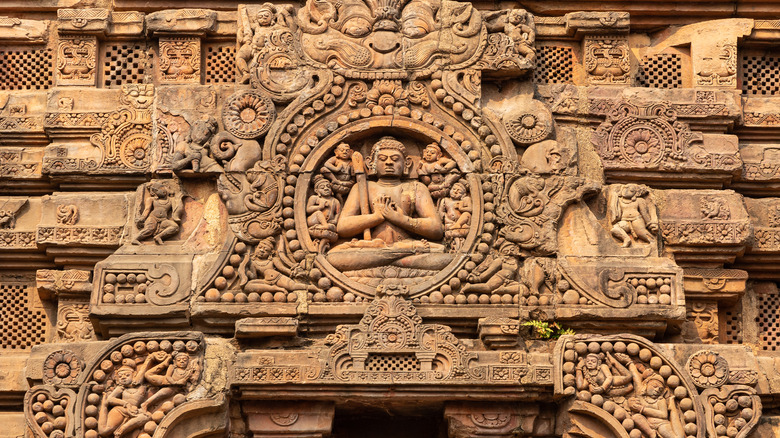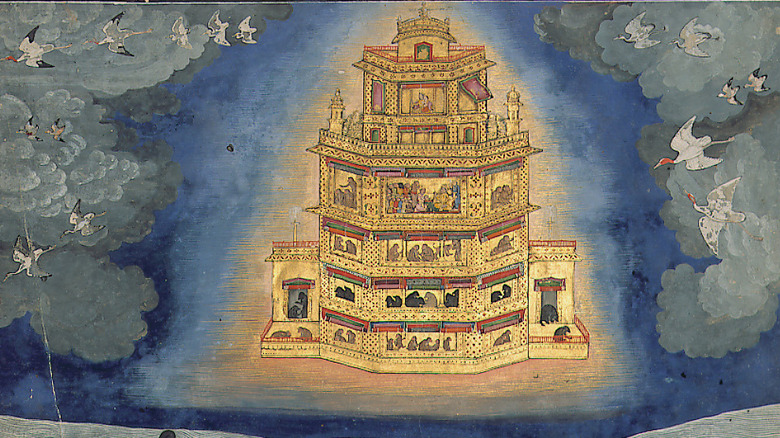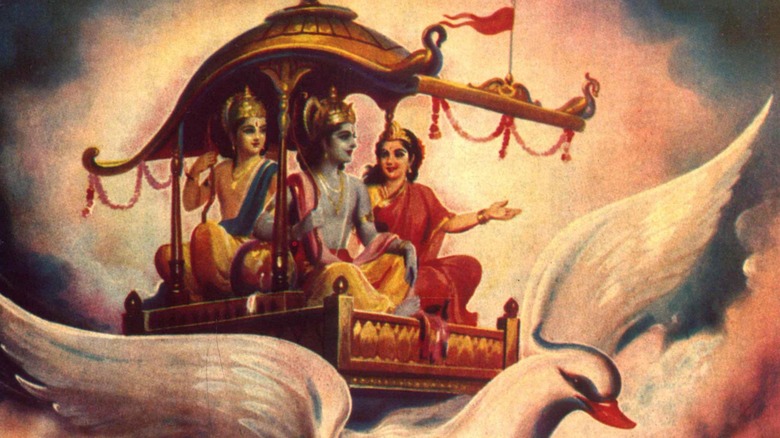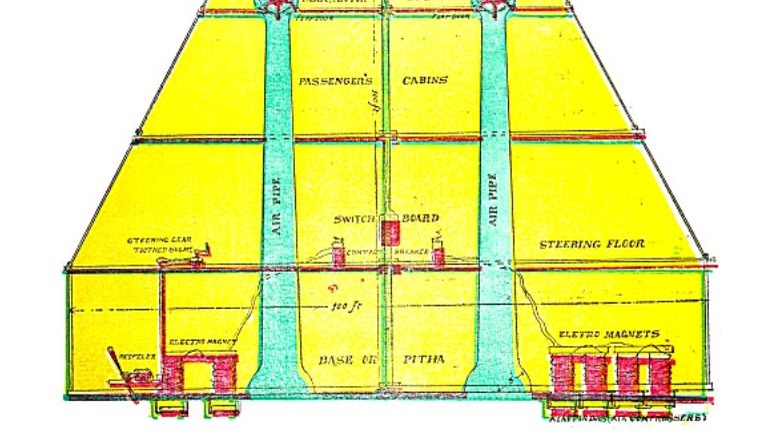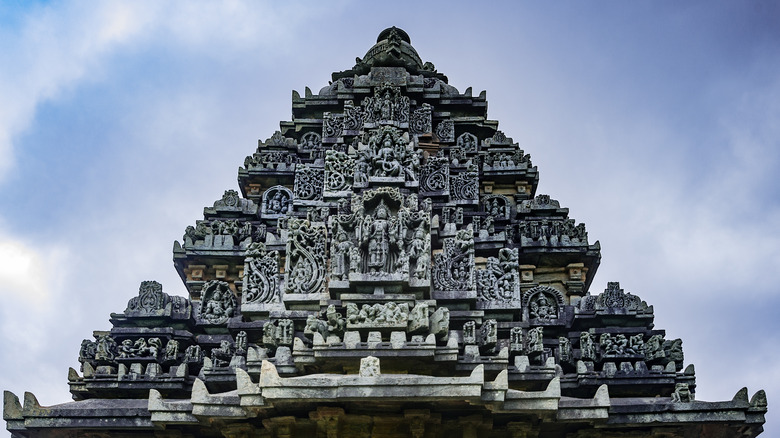The Unexplained UFO-Like Flying Objects In Ancient Hindu Texts
No matter how many historical, archaeological, and anthropological advances we make, the ancient world remains teeming with unexplained mysteries. Some, like the 40,000-year-old Lion Man ivory sculpture found in Stadel Cave in modern-day Germany, are impossible to ever fully understand. And yet, as the British Museum explains, the half-lion, half-human figure's supernatural significance is fairly obvious. Others, like the famous, 4,500-year-old Stonehenge in Wiltshire, England, act as a 365.25-day-long solar year calendar, per Vice. But, we have no idea exactly who built it.
Yet other mysterious ancient sites, monuments, artifacts, and texts tend to conjure explanations of a far more unconventional variety. Or at least, they seem to hint at happenings far more uncanny than folks dragging giant stones into place to erect a monolithic calendar. Some believe, for instance, that reliefs on the Temple of Heusalesvar in Halebid, India, depict ancient people wearing space helmets and spacesuits, as Earth Chronicles describes. The Statesman goes several steps further and declares that a 10,000-year-old cave painting found in Madhya Pradesh and Chhattisgarh, India, depicts a UFO with tripod-like legs for landing.
India, in fact, out of all global locations, is a favored choice amongst certain online circles for discussions of "ancient astronaut theory," the belief that aliens visited Earth in the distant past (popularized by shows like "Ancient Aliens"). Sites like Mystery of India point to India's oldest, most sacred religious texts as containing descriptions of flying saucers, god-like aliens, and even intergalactic space battles.
Millennia of oral tales
When we talk about ancient Indian religious texts, we mean the Vedas, a set of Hindu poetic verses written down language sometime between 1,500 B.C.E. to 500 B.C.E., as World History Encyclopedia explains. Before then, the Vedas were part of an oral tradition spanning hundreds, if not thousands of years within the Indus Valley. The region's indigenous Harappan people, who settled in the area around 7,000 B.C.E., played host to waves of Indo-Aryan migrants from further west. From the merger of these two groups, we get Vedic culture dating back to around 2,000 B.C.E. The Vedas got written down sometime after this when the Sanskrit language took hold in the region.
The Vedas are split into four main books — the Rig Veda, Sama Veda, Yajur Veda, and Atharva Veda — totaling over 100,000 verses (per BAPS Swaminarayan Sanstha). As Indian Express explains, poets devised ingenious and complex rhyming strategies to help them memorize such a gargantuan body of work. For example, they'd assign numbers 1 through 5 to the words in a sentence like, "The sun is shining today." Then they'd repeat the sentence according to a 1-2 2-1 1-2 (the-sun sun-the the-sun) | 2-3 3-2 2-3 (sun-is is-sun sun-is), etc., pattern. In the end, such Herculean efforts not only depict the importance of the Vedas but ensure that they remain as accurate as possible. So when the Vedas talk about flying machines that sound like UFOs? Those descriptions haven't changed over thousands of years.
Chariots of the gods
So what do the Vedas describe, exactly? As World History Encyclopedia says, the Vedas are largely concerned with instruction regarding the proper observance of religious rituals: mantras, chants, general "how to" guides regarding this or that rite for this or that god, lines to speak when officiating a wedding or funeral, and so forth. They also contain hymns to particular gods, stories of the formation of the universe, and loads of philosophical inquiry into concepts of truth, selflessness, devotion, birth and rebirth, the purpose of human existence, etc., as UN Academy expounds. And yes, they talk about the gods' special sky chariots: vimanas.
As Indian Yug says, the original Sanskrit word "vimana" means "measuring out, traversing," or "having been measured out." And in the Vedas, this is exactly what vimanas do: they're like a royal carriage or palanquin, or a multi-level pagoda that zooms around in the air. They take the gods here and there, fly high up into the sky, travel great distances, and can possibly even travel through time. Artwork depicts them looking much like stereotypical, modern-day, disc-shaped UFOs. Sites like My India My Glory, Radha, Mystery of India, and more all define vimanas in technological, non-symbolic terms, like actual, constructed, mechanical vehicles; this makes sense seeing as we live in an age defined by technology. As Indian Express explains, researchers in the 1970s at the Indian Institute of Science in Bangalore even tried constructing vimanas based on textual passages. The study tanked.
Wheels of fire in the sky
Some descriptions of vimanas are predictably vague and suited to poetry. As Indian Yug quotes, such descriptions include, "Along the dark course, tawny well-feathered (birds) clothing themselves in the waters, fly up toward heaven," and, "The chariot wheel (of the Sun) is one, its wheel segments are twelve, and its wheel naves are three: who understands this?" Other, early descriptions of vimanas resemble wheeled chariots pulled by horses, except the chariots fly. Folks familiar with the Bible might recognize echoes of this description in the Old Testament story of Elijah getting taken up into heaven in "a chariot of fire and horses" in the Book of Kings, as Bible Gateway recounts.
The "Pushpaka" is the first, truly technological-sounding vimana mentioned in Hindu texts. The Pushpaka Vimana was a bespoke vehicle intended for the god Brahma, which makes its way into further tales. On Indian Yug, the passage reads, "The Pushpaka Vimana that resembles the Sun and belongs to my brother was brought by the powerful Ravana; that aerial and excellent Vimana going everywhere at will ... that chariot resembling a bright cloud in the sky ... and the King [Rama] got in, and the excellent chariot at the command of the Raghira, rose up into the higher atmosphere." If this was the extent of descriptions of vimanas, however, it's doubtful anyone would liken them to UFOs. From there, though, things get oddly specific and detailed.
Engines of spinning mercury
Even though vimanas are sometimes described in vague poetic terms, other times they're described in very precise, concrete terms. Research from Jain University published on Research Gate discusses a variety of vimanas like the two-engine Agnihotra vimana, the multi-engine "elephant-vimana," or the Hasti-yantra, a flying device used in combat to frighten elephants. The 11th-century Indian king Bhoja talked about vimanas having 32 total features, while Historic Mysteries describes 113 various types of vimanas. Some like the Rukma were conical and golden. Others like the Sundara were silver and rocket-shaped, or as Mystery of India puts it, cigar-shaped. Vimanas were also housed in Vimana Griha, a kind of vehicle hangar.
Sometimes, as Historic Mysteries says, vimanas resembled solar-powered vehicles and captured the energy of the sun through energy-absorbent glass tubes. Other times they're described as being powered using spinning mercury combined with some kind of fan, per Air Power Asia. Sites like Radha and Biblioteca Pleyades go into detail about how such an engine might be built, despite the aforementioned failed 1974 study (per Indian Express). And lo and behold, mercury vortex engines (as they're called) are a real, plausible technology, as Science Direct explains. Further to the point, the Indira Gandhi National Center for the Arts says that the Vedas mention metalworking using materials like gold, iron, and copper. Minimally, therefore, it's at least plausible that ancient India could have been capable of working with the kinds of materials needed to craft UFO-like vimanas.
A high, holy place
In the end, what are we to make of all this discussion of ancient, UFO-like flying saucers? If we take sources like Air Power Asia, Radha, and Biblioteca Pleyades as representative examples, then there's a fair share of folks who earnestly believe that the vimanas described in texts like the Vedas refer to actual, ancient flying machines. Push too far into speculation, however, and we run the risk of rubbing elbows with fringe thinking like that of ancient astronaut theory. Discount available texts too much, though, and we run the risk of taking a disparaging stance toward the capabilities of ancient peoples. That final concern, however, reveals everything we need to know about the truth of vimanas.
As New Republic discusses, the flurry of interest in vimanas reveals the desire of modern-day India to lay claim to a deep, historical identity that belongs only to itself. Vimanas represent a golden era of India that predates colonization and extends beyond the concerns of 20th and 21st-century party politics. Their stories are a way for people across India to identify their own capabilities and potential and to point to a grand past as a benchmark for how good things can get in the future. This is why, as the Sivananda Yoga Vedanta Center describes, vimanas are also the name for the topmost part of a temple pyramid, the sanctum sanctorum where the gods dwell. They're a symbolic high place beyond reach and desecration, inspiring and untouchable.
